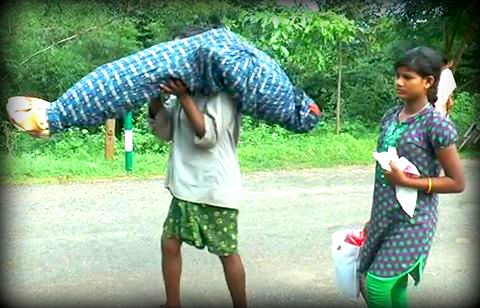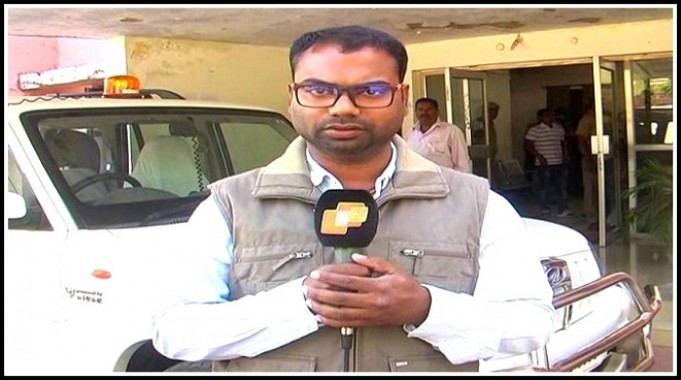Don’t shoot the messenger
Ajit Singh photographed doing a piece to camera for OTV
Following the haunting picture of Dana Majhi, 49, a tribal in Kalahandi district, Odisha, carrying his dead wife on his shoulders for nearly 12 km because he failed to get a mortuary van from the hospital where she died, questions are being raised about the local journalist, Ajit Singh, who shot the image that was first aired on OTV and then exploded in the national and international media.
Some people on social media have criticised him for not helping Majhi. The ethics involved in this kind of situation have been widely discussed.
‘It pained me when many ill-informed people disparaged me on social media for shooting the visuals of Dana Majhi. But let me tell you that I helped him in every possible way that I could at that time, starting from informing the administration to the hospital officials to coordinating with the local representative to arrange a vehicle. At the same time I am a journalist. I thought if I will cover/shoot Dana’s plight and air it, then may be the government will wake up and address this issue so that in future no other Dana Majhi has to carry the dead on his shoulder. I have an obligation towards humanity and towards my profession as well. Where did I go wrong?” asked 33 year old Singh.

Dana Majhi photographed in August carrying the body of his dead wife
Singh himself comes from Kalopala village in Kalahandi district, a poverty stricken area. In 2006, he decided to become a journalist. ‘Of course many of my generation who have come to this profession considering this a glamorous world but believe me I came to this profession to do some good work for the people. I belong to an area where the poverty and deprivation is deep rooted since years. Though my family is not so poor because my father is a government employee, I have seen the poverty and the pain of the people since my childhood. I wanted to be their voice so I decided to become a journalist,’ said Singh.
After getting a call at 5 am from unknown person who had seen Majhi on the road, Singh picked up his cameraman and managed to find Majhi and his distraught daughter. He stopped him and asked him to put his wife’s body on the road side. Majhi related the whole story of how he had finished all his money on treatment for his wife’s tuberculosis. He pleaded with the hospital staff to provide a mortuary van but they failed to respond, leaving him no option but to carry the body on his shoulder.
Singh says that he was distressed to hear this but not surprised. ‘I knew how our health care system is running here. So the first thing that came to my mind was to help Dana shift the body to his village in a dignified way. As I was on a bike, I had to arrange an ambulance for him. I made a call to our district collector who said she would ask the Chief District Medical Officer (CDMO) to arrange the mortuary van, then the CDMO called me up and said the van is not available. Then I contacted MLA Balbhadra Majhi and asked him for help. He promised to help.
“Then I called Mr Pramod Khamari, a member of the Balaji Temple Surakshya Samiti, an NGO. Luckily he agreed to send the mortuary van. The van reached to us after half an hour and with the help of the locals who gathered there by that time, we kept the body in the car and sent Dana to his village. I gave him some amount available at that time in my wallet. As a human being I think it was my duty to help that poor Dana as best possible but being a journalist it was my duty to show the truth to the people. For me as a journalist this was not an isolated case. I saw this is a bigger issue of the failure of government policy and an example of non-implementation of the government schemes meant for the poor,’ said Singh.
He has worked for OTV since 2009 as a stringer, paid per story. His monthly income comes to about Rs 5,000-6,000 and even that is not regular. Singh has covered many tragic stories of poor families in Kalahandi during his career but it was this one that generated a public reaction.
Journalist Saba Naqvi, during a discussion on “Labour Exploitation and Slavery in India: Role of Media, Government and Civil Society” on 31st August in New Delhi, said: “It was so disturbing to see the pictures and more disturbing was the reporter whose camera was following Dana Majhi in such a distressing condition. The reporter himself could have carried Dana Majhi in his car. Instead of doing this, he was taking his visuals.”
Naqvi should not be blamed for her remark because many journalists in the state or national capital have the feeling that journalists in remote areas are as well paid as they are and enjoy the same facilities as they do. The reality is not so rosy. Most reporters, like Singh, are not on the payrolls. They either have to work on consolidated pay or work as a stringer. The payments are irregular. They don’t have the basic infrastructure needed for working in remote areas. To assume that this kind of reporter goes around covering stories in a car is a day dream.
These reporters face the threat of malaria, jaundice, and tuberculosis. Kalahandi’s Thuamulrampur area is also affected by Naxalites so there is a risk to their lives too, and that too with no social security system.
“It disturbed me when my fellow journalist is being criticised in the social media with insensitivity. Here in Kalahandi district there are at least 200 villages in three blocks like Thuamulrampur, Jaypatna, and Lanjigarh area where till date there are no paved roads, electricity, or safe drinking water,’ said Rajani Kant Mishra, a Kalahandi-based senior journalist from Odia daily Nitidina.
‘We have tried our best to highlight these issues over the years but not a single government official nor any mainstream journalists from the national dailies or TV bother to step into these places unless there is a story like this one. Ajit’s report on Dana at least informs the world that we are existing in this situation after 70 years of independence. Dana Majhi was flooded with assistance after this news only.’
Kalahandi has many times made the news: for the sale of children, starvation deaths, drought, or other reasons. That’s why all the local news channels like OTV, ETV (Odiya), Kalinga TV, News 7, ZEE Kalinga, Naxatra News, News World Odisha and Odiya daily newspapers like Sambad, Samaj, Pragatibadi, Samay have a reporter in the district.
About 150 journalists work in different blocks and panchayats of Kalahandi district. Of these, only 10-12 journalists based in the district headquarters of Kalahandi are on the payroll. That means that most of the journalists are not covered by any kind of social security system from their organisation.
“Most of the people don’t know that in a place like Kalahandi, many journalists who report from the interior pockets are as poor as Dana Majhi. Most do not get a monthly salary or payment. You will be surprised that many of the national dailies and the TV channels do not have their correspondents in the state capital at Bhubaneswar, forget about Kalahandi. It shows that the national mainstream media don’t consider Odisha as their news hub though cases like Dana Majhi have proved them wrong,” said Prasanna Mohanty, executive member of the National Union of Journalists.
Dillip Das, chief functionary of Antoday, a Bhawanipatna-based NGO, said he found nothing wrong with Singh taking the visual of Dana Majhi carrying his dead wife on his shoulder.
‘Rather I would congratulate the journalists who have highlighted this sensitive issue. We should not take Dana as an isolated incident but as an issue of poverty, deprivation and the government’s apathy. We have seen journalists who raise these issues often becoming the target of the administration. Ajit Singh‘s courage should be appreciated,’ said Das.







